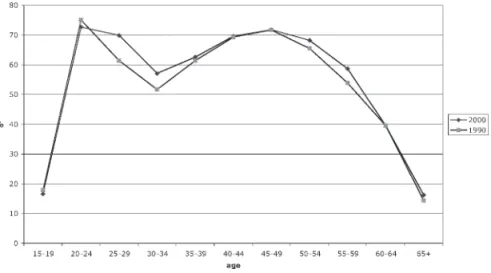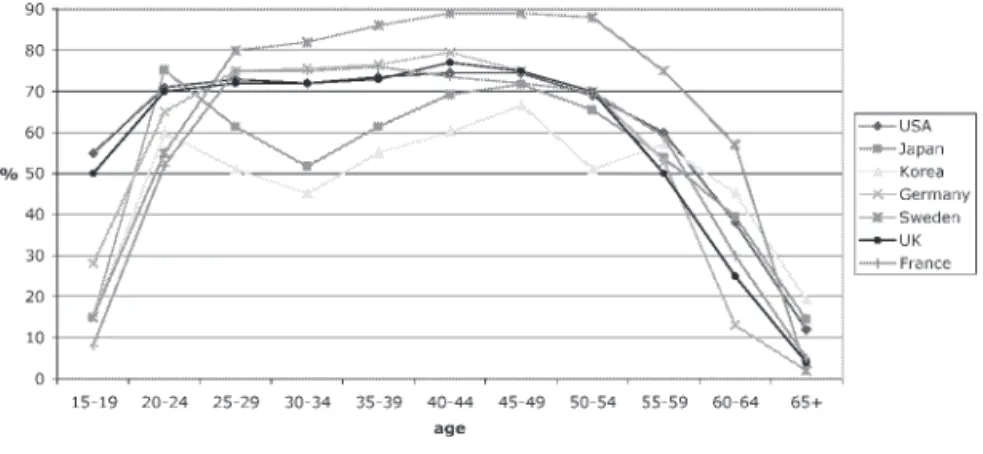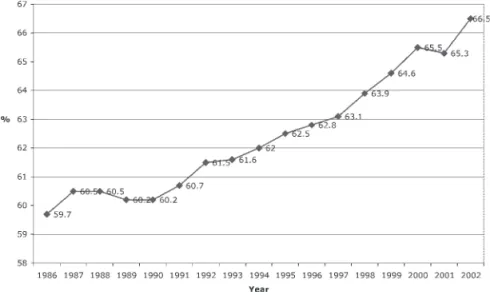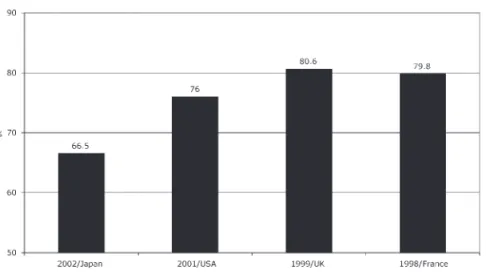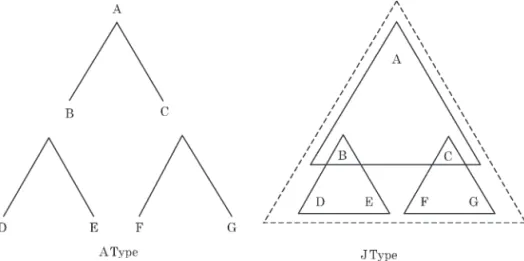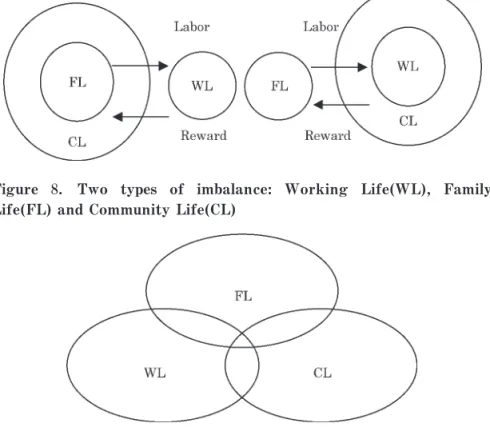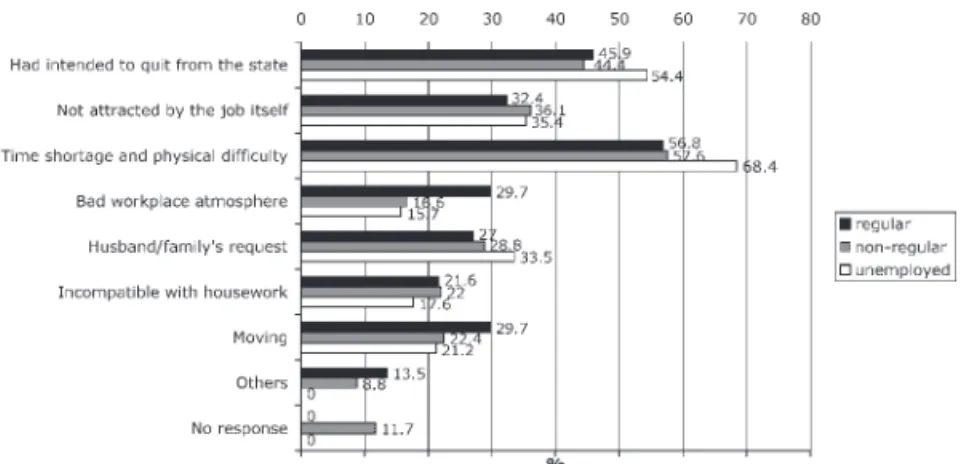熊本学園大学 機関リポジトリ
Merits and Demerits of the Gendered Business
Society
著者
中野 裕冶
journal or
publication title
The Study of Social Relations
volume
10
number
2
page range
83-96
year
2005-03-25
Merits and Demerits of the Gendered Business
Society
Hiroharu Nakano
Kumamoto Gakuen University
Preface
Business Administration was born from the end of the 19th century to the beginning of the 20th century in the process of taking the notions of capital movement (assets)and transferring it to management of organiza-tions.
The global economic activities of the following century,which emphas-ized the mass production and the improvement in income(mass consump-tion) have resulted in negative points with issues of environmental destruction.
The new century is facing these negative aspects of the economic activities by forming a new paradigm that moves away from the needs of the producers toward the needs of the consumers (citizens). This moves management from simple questions of cost management to the need to accurately perceive the needs of society to create new values. For Japan, I will suggest that this means addressing the notion gendered business society.
In order to address that notion, I will first discuss the relationship between Capitalism and gender discrimination, followed by which will attempt to relate Capitalism to, and followed by a discussion of the evolution of gender roles and changing attitude towards them in the workplace and go on to suggest a Work-Home Society model that would
aim at restoring a balance between the workplace and home.
I. Capitalism and Gender Discrimination 1. Human nature and Economic Structures
⑴ As long as human-beings are social creatures (animals),they cannot survive alone. This causes the eternal ambivalence between freedom and social constraints surrounding their social lives. In this sense, human nature has two phases---sociality and animality.
Sociality or cooperativeness among people is the essential to make an organization,whereas without animality or self-interest,one could not have enjoyed any kinds of exchange at the market.
⑵ Four Types of Economic Structures
As shown in the Figure 1,referring to the human nature,we can get four types of economic structures which are derived either from stress-ing self-interest (market)or cooperativeness (organization).
Among them, Japan seems to belong to category of Organizational Capitalism. Restructuring and the adoption of market principles into this country, which have recently been spearheaded by Prime Minister Koizumi, seem to me to move toward Market Oriented Capitalism. In view of human nature, however, the well balanced Economic Structure requires a balance between self-interest and cooperativeness. In this
State/Market Self-Interest Cooperativeness Enterprise Orgn. Self-Interest Market-Oriented Capitalism Market-Oriented Socialism Cooperativeness Organizational Capitalism Organizational Socialism Figure 1. Four Types of Economic Systems
sense the recent Japanese evolution should be limited within the system of Organizational Capitalism.
Supposedly, Market Oriented Capitalism correspond to U.S.A, Organ-izational Socialism,to Soviet Russia,whereas Market Oriented Socialism to China at the time between 1979, when Deng Xiaoping restored his sovereign status and 1992 , when the declaration of Socialistic Market Economy Line was held at the 14 Chinese National Peoples Congress.
2. Labor and Sexuality ⑴ Capitalism and Gender
Before Capitalism, there was a household community in which a typical working style had kept the continuity between in-house and the outside work. As the development of Capitalism,characterized by the development of an exchange of commodity (including labor power) system, the discontinuity between in-house work and outside produc-tive labor occurred. Accordingly, after the establishment of abstract and general labor in market, productive labor was conceived as a social-rational-civilized public matter.
On the contrary,the housework and reproductive in-house activities became to be thought as a sexual and private matter. This phenome-non deserves to be conceived as a separation between labor and sexual-ity.
In short, historically and logically, Capitalism has always required social and productive male workers who constantly could supply stable and continuous labor power as a commodity, expected to be productively consumed.
In Japan,through the era of highly economic growth,the role distinc-tion based on sex has been embedded both in workplace and household.
This economic-based society deserves to be called a gendered business society.
II. Japanese Style of Management and Gender 1. Todays female workers
⑴ World Trend
There are two main world-wide streams which seem to be aimed at the empowerment of female workers. One stream started in 1975, when the Mexico Declaration was announced. The other is surround-ed by the International Labor Standards Law,in particular,the stream which has started from CEDAW (Convention of the Elimination of All Discrimination against Women) settled at the 34 United Nation in 1979.
As the fact shows that Japan ratified the CEDAW in 1980,Japan has not remained unconcerned to these streams. Actually, however, the Basic Law on Gender Equality in this country was settled in 1999,when almost 20 years have already passed. It seems to me that the em-powerment activity of female workers in this country has started and unwillingly been compelled under the pressure of the voice from abroad. Therefore,a critical question whether the Japanese have spontaneously tackled this issue to overcome any kinds of sexual discriminations as the CEDAW shows, remains.
⑵ Domestic Situation
1. According to the White Paper on Gender Equality in 2000,the ratio of the female workers to the total was 41.0% in 2003. The rate of labor power (the rate of working people over the age of 15) was 60.8%, which showed the faster pace of decrease than the forecast (62.6%)of Ministry of Labor in the year of 2000. (Table 1.)
2. Figure 2 and Figure 3 show so-called letter M curve referring to the rate of Japanese female labor power classified by age. Sudden fall of the percentage between the age of 30 and 34 shows the urgent need to establish a support system of compatibility between work-place and household.
Labor power forecast
Year 1990 1999 2005 2010 Rate of labor power M&F F 61.3% 50.1% 62.9% 49.6% 62.6% 49.2% 61.6% 48.6% Working population M&F F 6384 2593 6779 2755 6856 2775 6736 2744 Table 1. Ministry of labor s rate of labor power forecast Source: Basic Policy for the Equal Employment Opportunity Program 2000
Figure 2. Rate of Japanese female labor power classified by age Source: Labor Force Survey,Statistics Bureau:Ministry of International Affairs and Communications
Note:USA age 16-19 Figure 3. Rate of female labor power classified by age among devel-oped Countries
Source:USA, Japan, Korea:ILO Yearbook of Labor Statistics 1999 Germany, Sweden, UK and France: EU: Eurostat Labor Force Survey Result 1997
Figure 4. Number of regular and non-regular female employees Source: Labor Force Survey by Statistics Bureau:Ministry of Interna-tional Affairs and Communication
Figure 4 shows the recent trend that the numbers of regular and non-regular female workers in this country are converging.
3. Figure 5 shows the wage discrepancy between male and female general (excluded part time workers) employees in these 17 years. Figure 6. is the international comparison at the moment around the year 2000. Indeed, since the year 1999, when some legal arrange-ments related to the equal employment opportunity law were im-plemented,the differential rate has been improved,but as the Figure 5 shows the leeway to be improved is still profound.
Figure 5. Wage differential between male and female general employees
Source: Basic Survey Statistics on Wage Structure (2000):Ministry of Health, Labor and Welfare
2. Japanese style of management and gender discrimination ⑴ Mosaic-like organization and monolithic organization
Two types of organization symbolized in Figure 7 is made on the assumption that A Type mosaic-like organization is that of a type of Market Oriented Capitalism like U.S.A.and J Type monolithic organi-zation is that of Organiorgani-zational Capitalism like Japan. The biggest differences between two are as follows.
1. In the A Type organization, symbols A, B, C..., indicate job or function , whereas in the J Type organization, they represent peo-ple. Thus, A Type organization is symbolized as a job based sys-tem, and that of J Type is a human group.
2. Labor market structures on which these two types of organization depend are different. In the A Type organization, if we take an Figure 6. International comparison of male-female wage differential Source: Basic Survey Statistics on Wage Structure (2000):Ministry of Health, Labor and Welfare; USA: Employment and Earnings (2001) Labor Department;UK,France:ILO Yearbook of Labor Statistics (2002)
example of C who has failed in his work and unqualified, another individual will be employed as C from the horizontal and open market. In the J Type system,after the graduation-snatching style of adoption, under a vertical in-house labor market, F and G are proposed to have a complementary relationship within a group C,F, G.
3. From the view point of management style,A Type has an organiza-tion= tool view, whereas J Type has an organizaorganiza-tion= cooperative view. For the mosaic-like organization (A Type), to attain its organizational goal,each person in charge of a certain functional role should be well controlled. In a monolithic organization (J Type), consensus of each participant is essential in terms flexibility. Thus A Type organizations are managed by control, whereas J Type organizations are managed through consensus.
⑵ Merits and demerits of a monolithic organization
In this way,as the dotted triangle line shows,the Japanese company Figure 7. Mosaic-like organization and Monolithic organization
is integrated under the concept of family analogy…a superincumbent household system. In Japan, J Type organization has enjoyed family analogical company system in which employees are supposed to stay long and trained through long term experiences. Multi-functional workers, OJT (On the Job Training), seniority based wage system which are thought as the main characteristic features of the Japanese Management System have been entrenched,especially through the era of high economic growth.
Furthermore, we cannot deny the fact that this system could only have been maintained under the condition of the occupation of main jobs by male regular employees, whereas female workers who are likely to leave at least for a while because of pregnancy, childbirth, child raising,elderly care etc.were excluded from the main arena of the business stage.
Needless to say, the gendered business society has contributed not only to the attainment of efficient productivity, but to the organ-izational cohesiveness which is the essence of the maintenance of competitiveness. The productivity and cohesiveness of an organiza-tion might be the merits of the gendered business society,as one side of a coin.
On the other hand, as shown in the Figure 8, when we broaden our views towards the relation between Business and Society, we cannot overlook the faults which both types of society inevitably contain from the view point of well-balanced model of working life, family life and community life. (Figure 9)
Under A Type of life style, the separation of spiritual life at FL(Family Life) and business life at WL(Working Life) is inevitable, while J Type of Life Style could only be maintained at the cost of
family ties.
⑶ Reasons to quit job and the change of consciousness of females toward job
As shown in Table 2, since 1984, the consciousness of Japanese females towards job has been constantly changing from the idea of retirement after marriage to the continuation of job even after child-birth.
Figure 8. Two types of imbalance: Working Life(WL), Family Life(FL) and Community Life(CL)
Figure 9. Working Life(WL), Family Life(FL) and Community Life(CL):Well-balanced Work-Life model
1984 1987 1992 1995 2000
Total
Prefer not to find a job Prefer to get employment until marriage
Prefer to get employment untill childbirth
Prefer to get employment again after child has grown Prefer to keep working after childbirth Others No idea 6.1 11.1 10.6 45.3 20.1 -6.9 3.4 10.2 11.3 51.9 16.1 -7.0 2.8 10.8 11.1 45.4 26.3 1.3 2.3 4.1 7.4 10.8 39.8 32.5 2.4 2.9 3.9 6.9 9.4 39.8 34.4 2.4 3.3 Table 2. Inclination and reasons to take employment (female) Source: Public Survey on Gender-Equal Society,Prime Ministers Office
Figure 10. Reasons to quit at the time of marriage, childbirth and childcare
Source: Questionnaire on Women and Work , The Japan Institute of Labor (1996)
However,as the Figure 10 shows,there are various kinds of reasons for those who leave work at the time of marriage, childbirth and childcare. Those reasons such as time shortage and physical diffi-culty, husband and familys request , and incompatibility with house-work , necessarily lead our attention to the hope for a realization of a well-balanced society among working life, family life and community life in this country.
Concluding Remarks
Finally, I would like to refer to some conditions for the attainment of a new well-balanced society. Besides the promotion of the government s current efforts in terms of legal administrative devices to the compatibil-ity of work and household, a revolution in the consciousness of manage-ment and male workers sides is essential. For the attainmanage-ment of this purpose, they should:
1. Not force female workers to the present highly esteemed but harsh position of male regular workers (ex.The case of abolishment of so-called Protection Law for Female Workers enacted in 1999). 2. Neither, instead, adversely force male workers to the
uncomfort-able situation of female workers (ex.low wage,unstuncomfort-able employment and deregulation of the regular workers).
3. Lead to a societal rhythm attuned to that of females societal and physical conditions in order not to treat the issue of childbirth,child raising and elderly care as the reproduction and care of labor power, but to treat as the question of the reproduction and cyclical life-patterns of human-beings.
Since the end of World War II,Japan has thought of family as a place to reproduce labor power. Its basic idea has been derived from the
enterprises logic of production ,which has contributed to strengthen the idea of sexual division of role.
Such socially prevalent ideas which seem to have been the backbone of the gender based and male centered business society,is now expected to be destroyed.
A distinct feature of the logic of production rests in its stress on means-ends conformity, in other words, formal rationality, whereas the logic of ordinary people (consumers) stress the importance of humanity, synthesis and totality of ones activity(works)itself…substantial rational-ity. For the time being, at the beginning of 21st Century, Capitalistic Economic Society will be developed focusing on a restoration of the balance between ones business life and every day family life.
